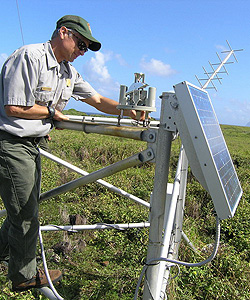What methods do scientists use to understand how our climate is changing and what causes it?

NPS photo
When faced with a question, scientists first develop a "hypothesis" and then subject their hypothesis to rigorous experimentation and observation, a process called the "scientific method."
Scientists test their theories and laws using data, preferably multiple types of data from multiple sources. A few sources of data are pollen, carbon trapped in ice cores, fish bones, and traditional knowledge passed from generation to generation. Scientists test their hypotheses against the data, using a set of steps that forms a methodology. They develop research processes that other scientists can replicate using the same data and steps to prove that the conclusions are sound.
Multiple proven hypotheses may be collected into a "theory," which summarizes several experiments and observations. Theories are lines of thinking that scientists accept as true. Scientists, however, make room for an exception, or for science to come along with new discoveries that can disprove previously accepted hypotheses and theories. A theory need not have 100 percent agreement to be valid, and theories seldom achieve unanimous approval. As new facts come to light, science adjusts its theory.
A "law" is a predicted set of observations with no significant exceptions. Theories do not "grow up" to be laws once they are proven. In fact, scientists are still refining Newton's laws of gravity, even though you probably agree that gravity is real and you are experiencing it right now.
As a scientific agency, the National Park Service's mandate requires that we base management decisions and policies on the best available science. The specific effects of climate change are uncertain: how fast and how much the temperature will increase, what future rainfall levels will be, and how many or how severe storms will be. Despite this, it would be far riskier to do nothing and leave the preservation of our nation's treasures up to chance. We must move forward with the best science we have today. Our mission demands that we do so.
Part of a series of articles titled Climate Change in Nth California and Sth Oregon .
Last updated: February 3, 2015
